The Cessna 185 banked hard left. A herd of caribou with two shooter bulls scattered across the runway below. The pilot considered lifting up to circle the landing strip once more, wanting to avoid an unintended caribou in camp on our fly-in day. But the herd cleared and we touched down on the ridge that would be home for the next week. An unbelievable start to our Arctic adventure.
…
This past season, two onX Hunt team members experienced the awe of an Alaska caribou hunt—one by boat, the other by bush plane. Both hunts had been a long time coming, with hours spent planning logistics, weighing gear and food options, poring over maps, and calling transporters. If you’ve spent any amount of time dreaming of chasing caribou, then you already have an idea of the level of planning required to witness—and hunt—the largest ungulate migration in the world.
To provide another resource for your DIY caribou hunt planning, we’re sharing Dylan Dowson’s August boat transporter experience and Jared Larsen’s September drop-camp experience.
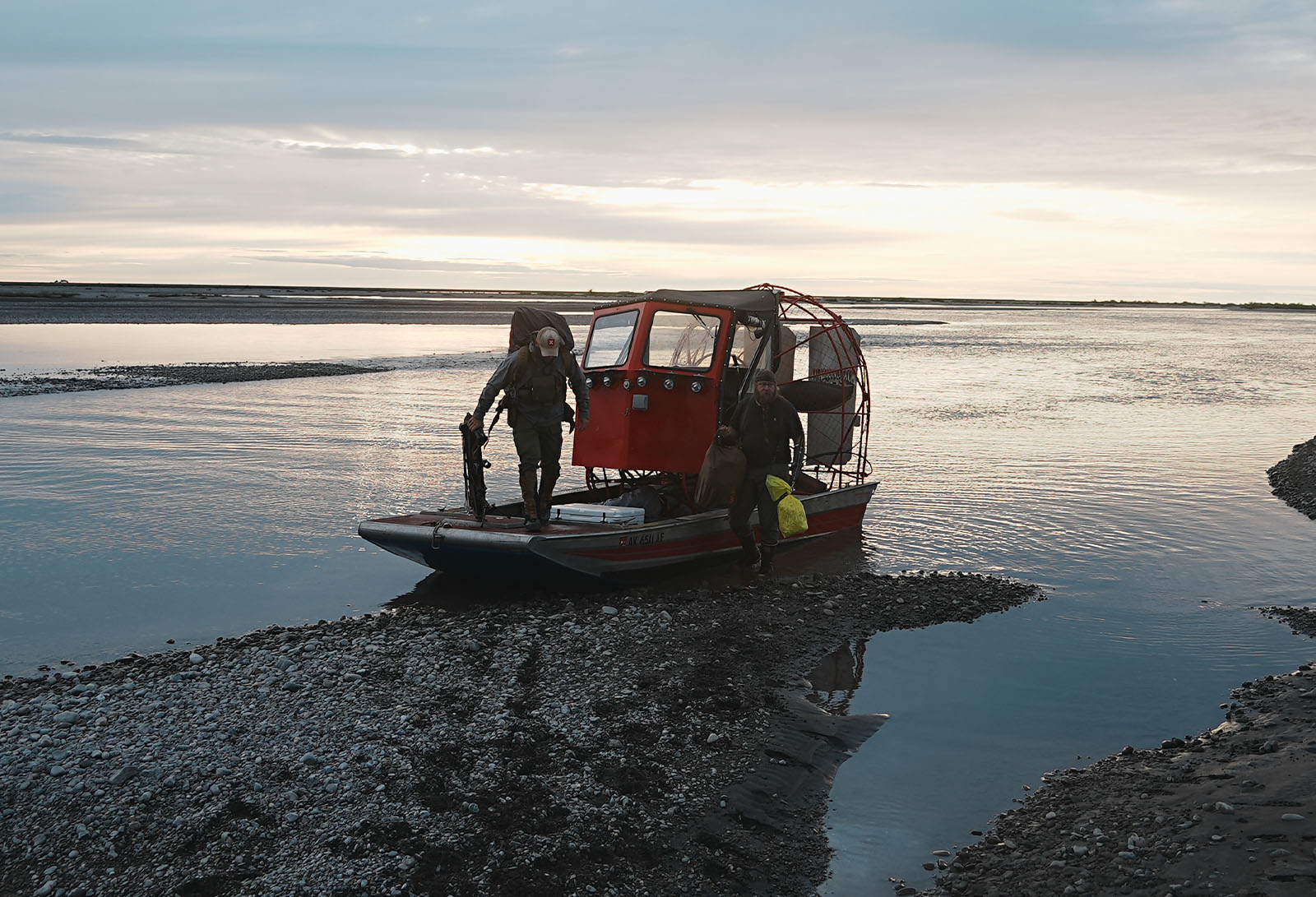
Hunt Snapshots: What We’re Comparing
We’re sticking to a side-by-side review of transporter options: boat and bush plane.
Dylan’s Hunt: By Boat
- Transport: Fan boat out of Deadhorse
- Timeframe: August 7 – 14
- Weapon: Archery inside the Dalton Highway controlled use area (accessed from a fan boat on the river, not from the road system)
- Animals seen: 6 caribou, 2 grizzly bears, 1 wolf, 15 musk ox, 1 wolverine, ptarmigan
- Budget: ~$6,000
Jared’s Hunt: By Plane
- Transport: Bush plane out of Kotzebue
- Timeframe: Sept 13 – 21
- Weapon: Rifle
- Animals seen: ~3,500 caribou, 5 grizzly bears, hundreds of ptarmigan
- Budget: ~ $8,500
Budget Overview
If you’re hunting caribou with a transporter, whether by water or air, you’ll need between about $5,400 to $11,100 to make the hunt a reality. Those prices represent your all-in cost, including commercial flights, transporter costs, tag costs—the whole nine. That is, except for gear, which will probably be another line item in your budget sheet, even if you’re already a Western hunter. Because gear options vary wildly, we’re not including it in the below cost estimate, but be sure you leave room in your budget for quality rain gear, both pants and jacket.
Cost Estimate Breakdown
When choosing between a boat transporter or a bush plane transporter, you’ll save a few dollars on the boat route, but you may appreciate the amount of land a little more cash affords you.
| ITEM | PRICE ESTIMATE | NOTES |
|---|---|---|
| Boat Transporter | ~$3,000 – $4,000 | Commonly taken from Deadhorse/Prudhoe Bay. |
| Bush Plane Transporter | ~$5,500 – $7,500 | Generally provides more latitude on the area you can hunt, and can allow you to target a specific herd (there are 32 recognized herds, but only a few offer hunting opportunity). |
| Commercial Airfare | $700 – $1,500 | You’ll need a flight into Fairbanks or Anchorage, and generally another puddle-hopper to the village where your transporter picks you up. |
| Caribou Tag | $810 | This covers the AK hunting license and Caribou tag. |
| Lodging | $600 – $1,000 | You’ll likely stay for a night in Anchorage or Fairbanks, as well as a night on each side of your hunt in an Alaskan village. |
| Trophy/Meat Transport | $300 | With planning, you can find companies that will ship your meat and trophies home for roughly $1.50/pound. Pricing figures about 75 pounds of deboned caribou meat, plus your new wall decor. |
| TOTAL BOAT | $5,410 – $7,610 | – |
| TOTAL AIR | $7,910 – $11,100 | – |
You’ll need between about $5,400 to $11,100 to make the hunt a reality. Those prices represent your all-in cost.
Timing Considerations
You may have little to no choice here depending on how far in advance you book a trip. Seasons open at the start of August and generally run through September. Most transporters don’t operate for the entire season as the weather can become too volatile toward the end of September to safely bring hunters into the field.
If you do have flexibility in your hunt dates, here are the main considerations to help you choose the timing:
Bugs
Wherever in the lower 48 you’re coming from, you’ve likely not seen bugs like you are liable to see in Alaska before a couple of hard freezes set in. Generally speaking, the last week of August through the end of the season will reduce the chances you get mauled by the greatest show of insects you’ll ever see.
Dylan’s group hunted in early August, and he explains, “Immediately after being dropped and while lugging gear from the river’s bank up to the bluff where we camped, we all realized we were in for it with the mosquitoes. I have never, NEVER in my life seen mosquitos like that. Thinking back to it now gives me the shivers. A bug face net, good spray, and a good attitude that lets you forget about them and hunt are absolutely necessary. The bugs got better when I finally gave up worrying about them and accepted there was nothing we could do about it.”
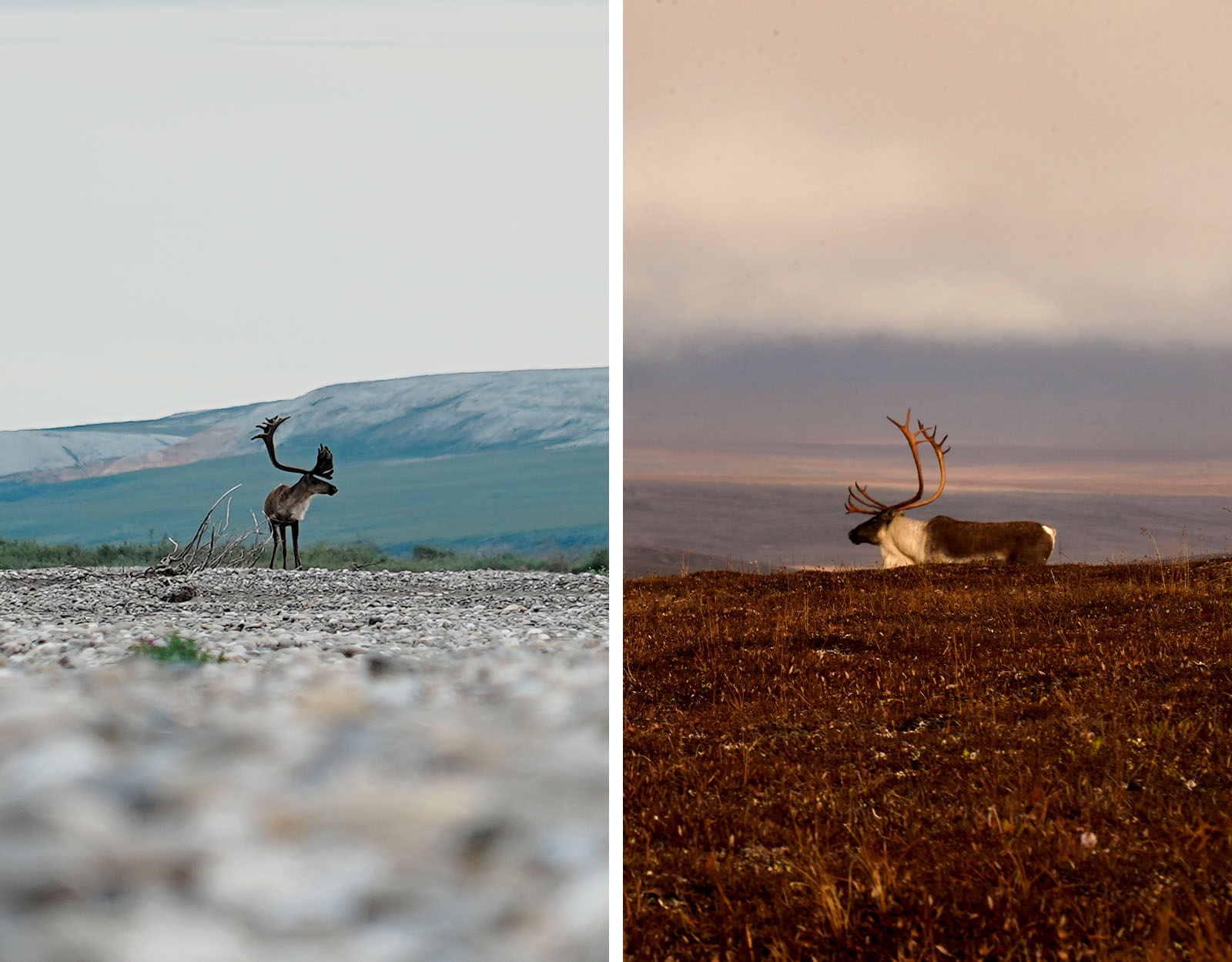
Velvet or White Mane?
What do you dream of when you close your eyes and envision your caribou? Do you see velvet antlers or an immaculate white mane? You can’t have both. For velvet, you’re looking at an August hunt with bugs and brown hides. For white manes, you’re in for colder weather and hard horns.
Dylan explains, “Originally, I would have chosen hard-horned bulls over velvet, but the way the dates and availability aligned, we decided on early in the season. Now, after having shot a velvet bull (my first animal in velvet ever), I will say they are really unique and cool. And, although still awesome, my bull’s cape was short-haired, saving me some money as I opted for a skull mount, leaving the velvet intact. Which reminds me, if you are after velvet bulls and want to keep the velvet, I suggest (as recommended by a qualified taxidermist) bringing at least a couple of bottles of VelvaLok along to help preserve the velvet in the field.”
For Jared, the decision was easy: “Our group members were all keen to shoot hard-horned caribou. Plus, as alluded to above, we didn’t really have a lot of options; those were simply the dates our transporter had available, and they happened to align with our desires. The capes of the bulls we harvested were beautiful and cost us all some additional funds at the taxidermist.”
Weather
Weather can be hard to predict, but for the most part, an August hunt is going to be warmer than a September hunt. Dylan says, “Our weather was manageable and ranged from the 50s and 60s during the day and dropped below 30 degrees in the evenings. We had about as many rainy days as dry, which is fairly typical in Alaska.”
Jared’s group had more incentive to keep moving, but still found the weather manageable. Jared explains, “For the most part, we had highs in the 30s and lows in the teens. Couple that with daily sustained winds in the teens to twenties and it was cold when on a glassing knob, but quite comfortable when on the move.”
“Decreasing temperatures and the first snowfall events of the winter were the main signals caribou used to decide when to migrate.”
The Migration
Ah, yes, the reason we’re all here. We’d love to be able to pinpoint the caribou migration, but it remains a bit of a mystery. The National Park Service partnered with the University of Alaska Fairbanks, using 2010-2018 GPS collar data from the Western Arctic Herd to better understand migration timing. They found, in general, that “decreasing temperatures and the first snowfall events of the winter were the main signals caribou used to decide when to migrate.” The study also noted that the caribou migration appears to be shifting later in the year as areas experience warming temperatures.
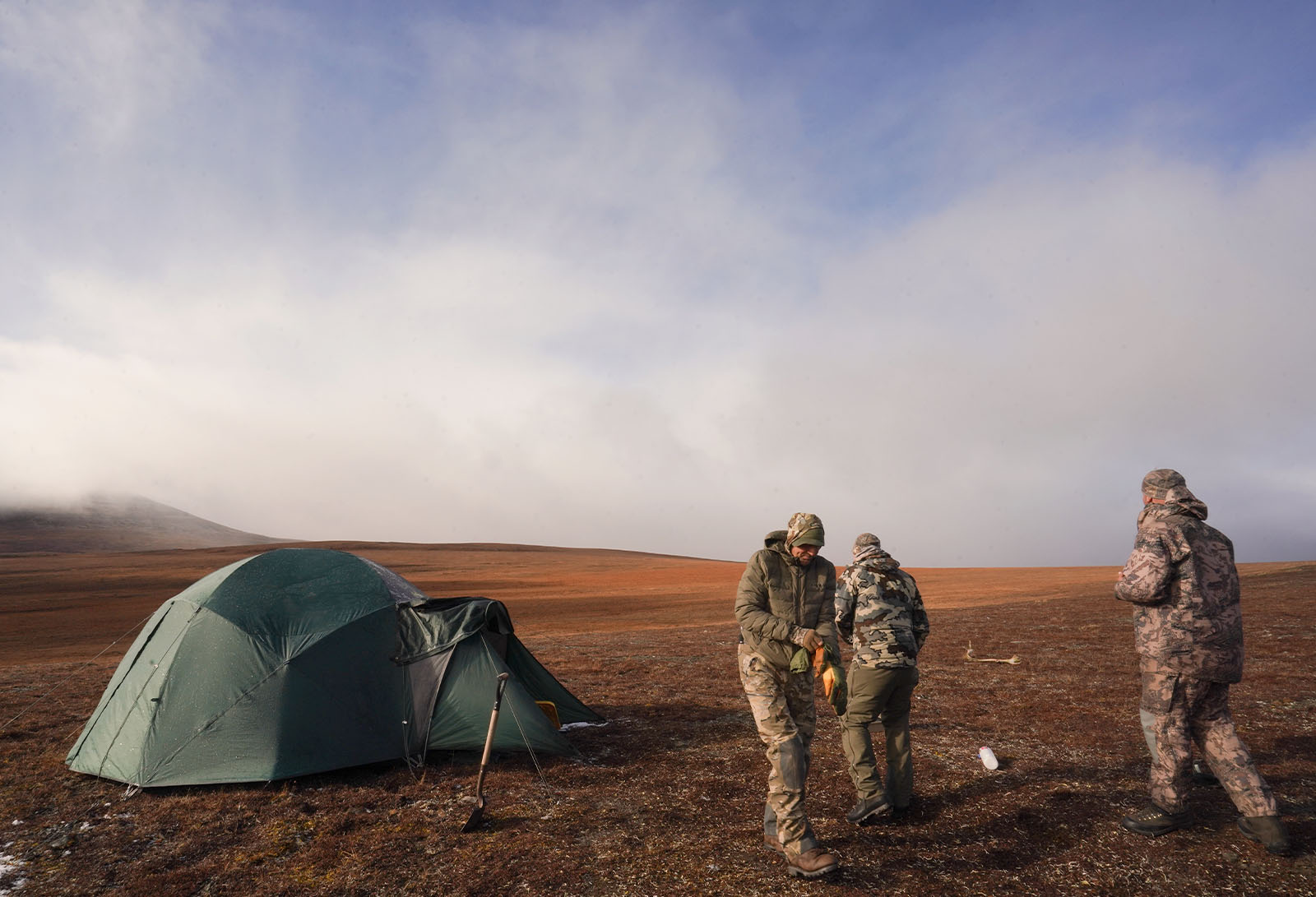
Managing Expectations
Because we’re talking about dream hunts here, you might have high expectations (or, at least, high hopes). While part of the fun is dreaming of ideal circumstances, here are a few areas where you may need to reality-check your vision.
Solitude
Jared’s Take:
Honestly, don’t expect it. The caribou hunts of the early 2000s are long gone and over-the-counter caribou opportunities seem to decrease every year. We flew out of Kotzebue. I’d read all the forum horror stories and went with, from my research, the most reputable transporter there. He told us we were his last clients of the year and that we would not be dropped within five miles of another camp. Well, we didn’t even get into the plane before that storyline crumbled.
We ended up sharing the flight with a solo grizzly bear hunter, who was dropped off on the same ridge as us. At first, we were annoyed (to put it lightly), but the turn of events ultimately ended up a blessing (a story for another time, but the short of it involves gaining a stellar camp mate and partaking in a pretty wild griz hunt). Then, within ten minutes of getting dropped off, we spotted another camp just 1.5 miles down the river from us (this is in addition to the camp the transporter mentioned, which was five miles down the river). At the end of the day, we could see other people in our glass, but it created no hunting competition and their hunt had no effect on ours or vice versa, outside of simply knocking our optimism down a peg due to the expectations that were created.
There were probably 80+ rigs parked there, also using one of the transport systems based in the same location.
Dylan’s Take:
Being we were hunting in the archery zone of the Dalton Highway, I expected a little pressure. At the same time, since we were using the transporter, we also expected that pressure to be mitigated a bit. Thankfully, that ended up being the case, at least while hunting.
We camped on the far side of the river in relation to the highway, creating a barrier of sorts. During our hunt, we watched two different groups of hunters attempt to hike their gear and a raft from the highway and cross the braided river system to our side. Both attempts ended in the hunters spending the better part of half the day getting across multiple braids of river, before realizing they bit off more than they wanted to chew (or perhaps before realizing we were already there) and turning back to their pickups.
Otherwise, we didn’t experience any hunting pressure near our camp. Though, when we returned to our loading zone at the end of the trip, there were probably 80+ rigs parked there, also using one of the transport systems based in the same location. We were told the rifle transport hunts were much more crowded and competitive.
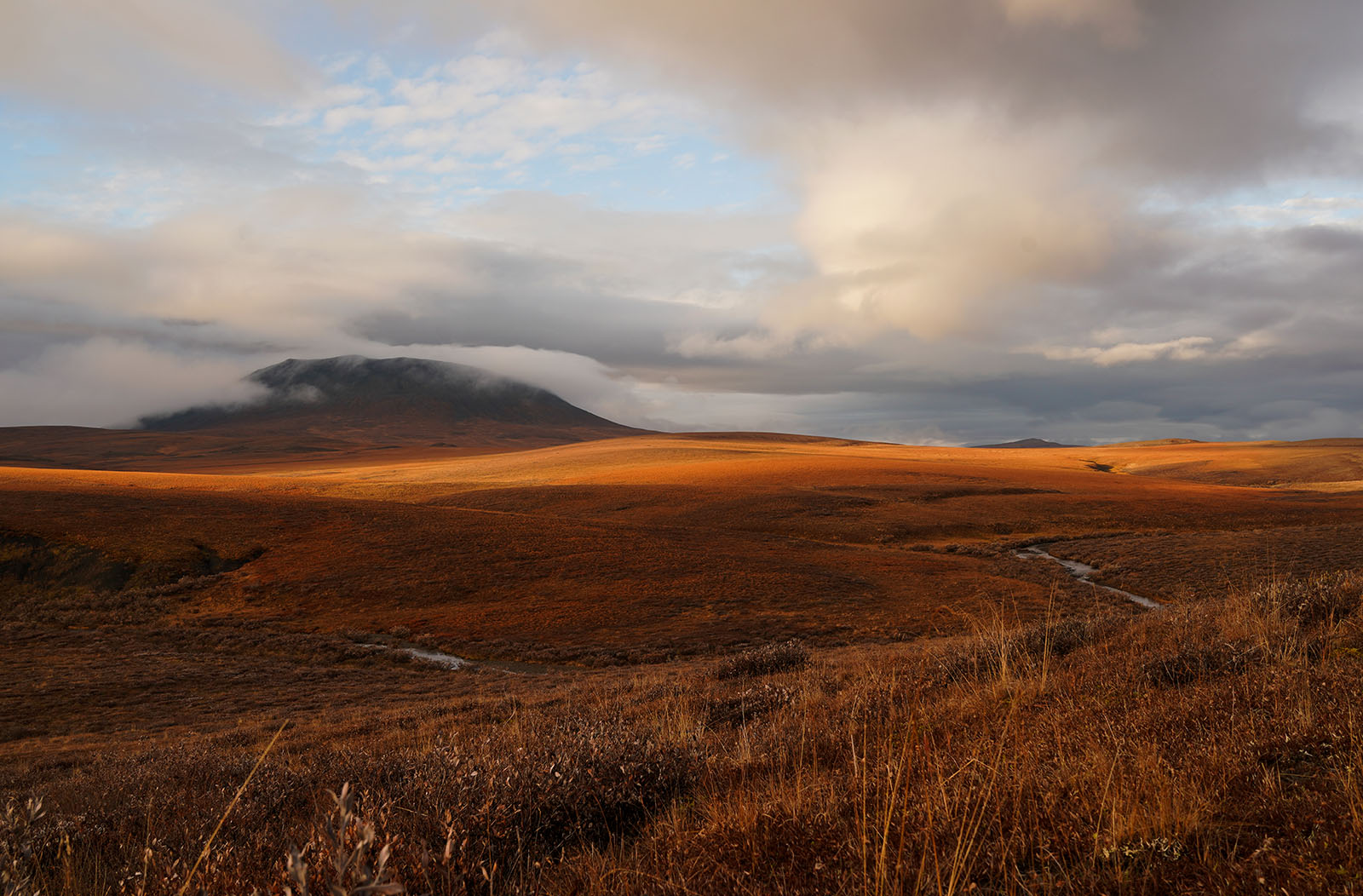
Animal Numbers
Caribou numbers, for the most part across North America, are on a drastic decline. It would appear a cocktail of contributing factors is involved, including concerns over climate change, hunting pressure, degradation of habitat and food sources, predation, and poor calving. The Western Arctic Herd is the most popular herd to be hunted in Alaska. In the early 2000s, the herd numbered close to 500,000 animals; it’s now down to about 150,000 animals. That said, 150,000 five-hundred-pound ungulates is still a whole mess of animals—and it only takes one to bring your dreams to reality.
Dylan’s Experience:
Most caribou hunts are migration-dependent, and frankly, the migration did not happen while we were there. We were left with hunting a few “resident” caribou. Fortunately, I harvested a nice bull with my bow on the third day of the hunt. Unfortunately, that was the only caribou bull we saw the entire week. We saw more grizzly bears than caribou bulls until we made it back to Deadhorse to fly out, where we were greeted by over a dozen “town bulls” that we would have given anything to be able to cross paths with on our hunt. The thought of the migration happening “any day” kept our hopes alive, but it never came. Unusually high temps right before our hunt seemed to have a factor in delaying things.
With each day, we saw fewer and fewer caribou, as if the proverbial faucet was slowly turning off.
Jared’s Experience:
For most of our hour-plus bush plane ride from Kotz I was working to manifest large herds of caribou on the landscape (for 90% of the flight, there wasn’t a critter to be seen). As soon as we neared our drop point, caribou began dotting the tundra and river drainages below. This is the exact reason that air transportation, in my opinion, is worth the cost.
The day we were dropped was far and away the largest migration day we saw. It’s difficult to give a precise number, but conservatively I’d say we saw 2,000 animals from our glassing knob that day. Many of these were miles (sometimes even 6 or 7) away, but nonetheless, it was one of the most incredible wildlife spectacles I’ve witnessed.
With each day, we saw fewer and fewer caribou, as if the proverbial faucet was slowly turning off. Our second day on the tundra and first hunting day, we saw in the realm of 1,000 animals. The following day, maybe 300-400, and by our third day of hunting, we saw fewer than 200 animals. By day four, we saw just one herd of 20 caribou. Onward to days five and six, and we didn’t see a single caribou herd.
Thankfully we had filled our three tags by day three, but had we not, things would have been extremely difficult. My token of advice here is, like any hunt, a caribou hunt can drastically change in a matter of seconds. Don’t let a bull walk that you’d be happy with for the alluring opportunity of a monster the next day, you just never know when chasing a migrating animal.
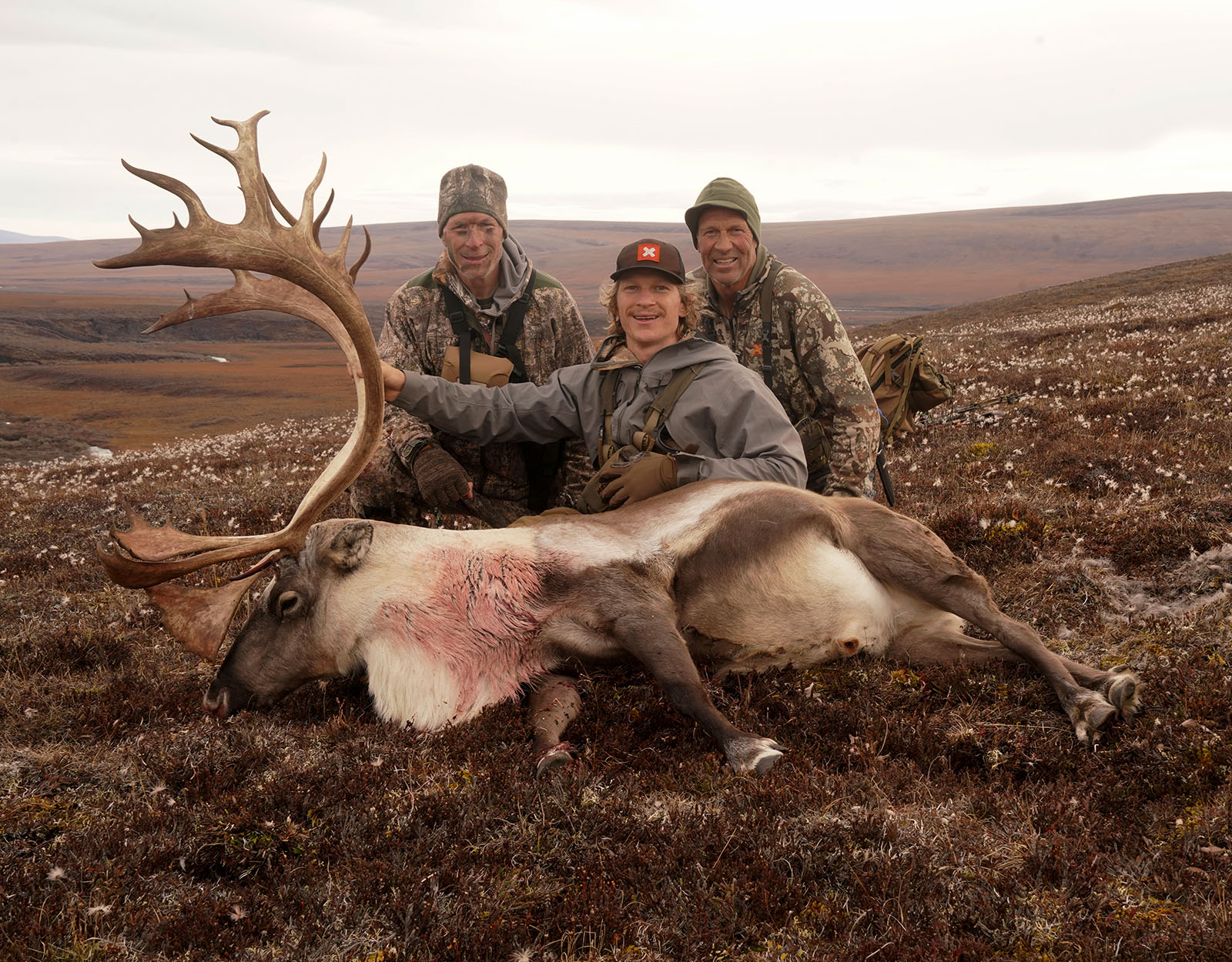
Planning Timeline
If you’re reading this blog and thinking you’re going to hunt caribou in Alaska in 2025, you likely will not be. Most transporters are booking two years in advance. That said, there are always cancellations, or maybe you have the ability to reach deeper into your pockets. Or, if you’re willing to contact every possible transporter in the state, you might find a hidden gem.
The easier path is to plan years in advance.
There may be a decent likelihood that you could get on a 2026 hunt if you put in the effort, get on the phone, and start making calls today. More realistically, your next opportunity is a 2027 hunt and that is just going to have to be something you are okay with throwing on the calendar and waiting patiently for. Of course, you can go hunt the Haul Road on a whim if you so choose, but make sure you go into this hunt with realistic expectations.
Closing Thoughts
We hope Jared and Dylan’s transporter-assisted DIY caribou hunts have helped you finetune what you’re looking for in your own pursuits, whether you decide to go by water, by air, or take your chances on foot.
We’ll leave you with a few closing thoughts from Dylan and Jared.
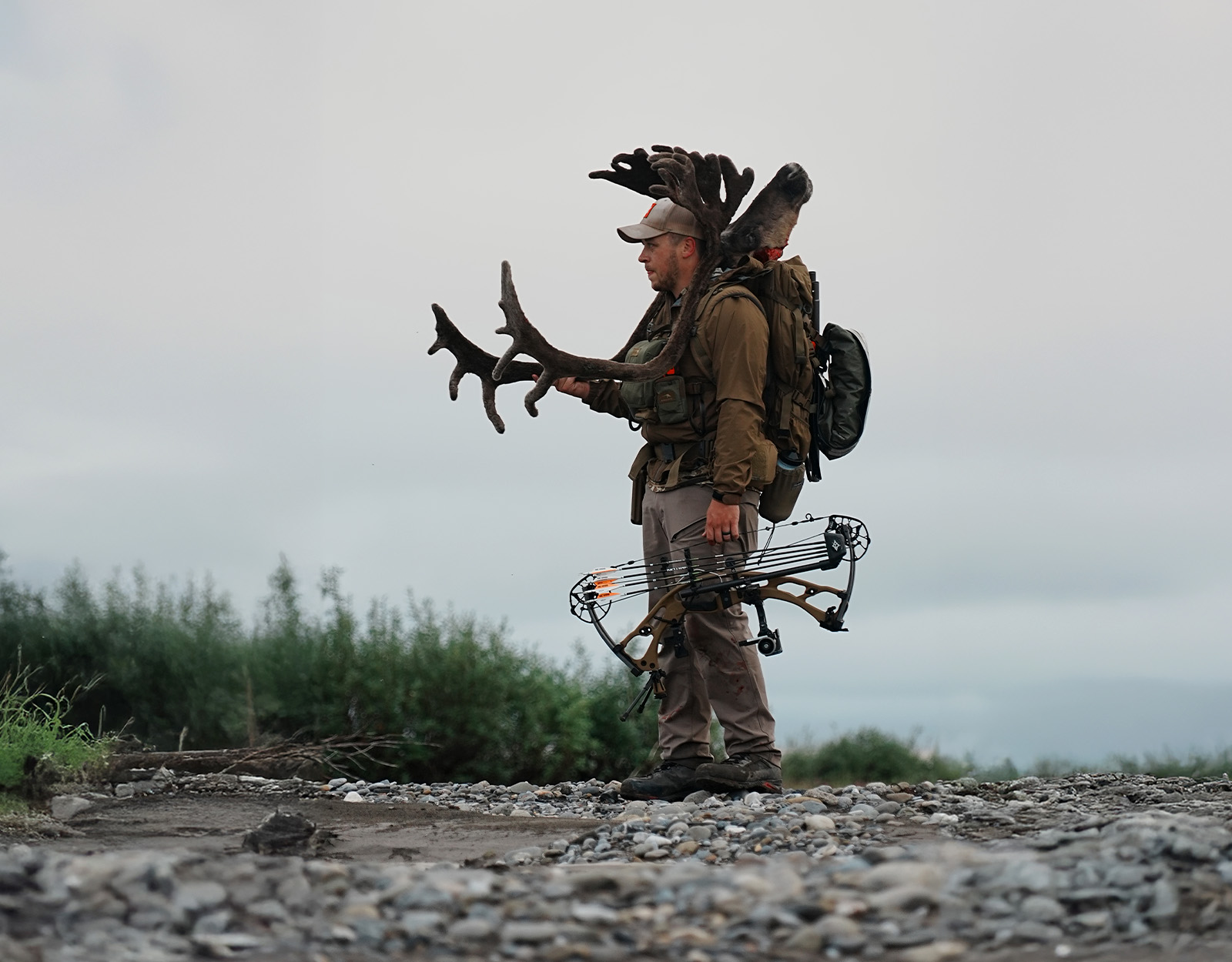
From Dylan: Don’t Underestimate Patience, a Packraft, or the Unpredictability of the Migration.
I quickly learned that caribou hunting is (at least where we were) more of a patience and “wait for them to come” game, especially after trying to traverse the marsh and tussocks for a few days. That is great if they are migrating and moving through your area but not so much if you’re stuck hunting only the few resident caribou in the area.
On day two, we spotted a lone bull from camp. For the next 24 hours, we all made stalks trying to get within bow range of him. He ended up going upriver about a mile and a half from camp and seeking refuge on an island in the middle of the river system. Being the only one who brought an inflatable pack raft (I would say a must on this hunt), I was up.
I solo paddled across the river system and made a long stalk on the bull. A couple of hours into the stalk, things worked out perfectly and my arrow connected with the bull’s heart. A few minutes later, I was standing over the first caribou bull I had ever seen or hunted and my tag was filled. We had five hunters in camp, two of us with two tags (you can purchase up to two in this particular area), so seven tags total. Of those, six went unfilled. Chalk it up to bad timing for the migration as we could go back to the same place and time next year and go 7 for 7.
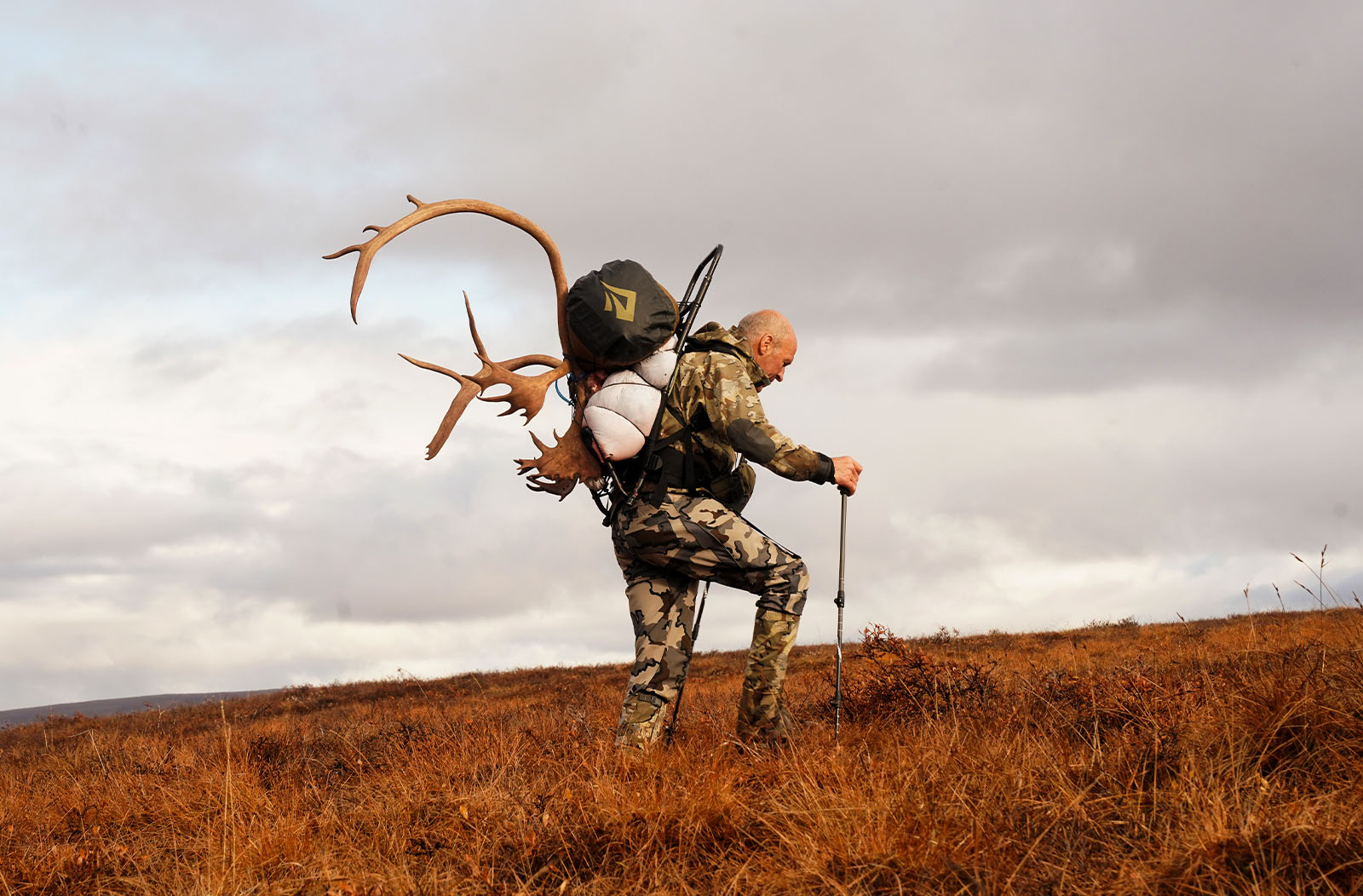
From Jared: It’s More Manageable Than You Think. And, Consider Bringing a Friend…
Having done a half dozen different Alaskan hunts for Dall Sheep, Mountain Goats, Moose, and now caribou, caribou is without question the easiest of these in terms of my DIY experience (I have a sibling in AK allowing me to chase sheep and goats without a guide).
If you can hack a true mountain elk or mule deer hunt, you can hack a caribou hunt. Though, walking the tundra is everything the internet says it is in terms of suck. The tundra tussocks will absolutely wear you down with every step, but after a short period of time, you learn which colors on the landscape guide you to easier walking. In short, if it is yellow/orange in color, avoid it, if it is brown/grey, that is the way. To the point where two miles of brown or grey is the chosen route over a half mile of yellow or orange, this sounds like a sham, but you’ll understand when you get there.
Unless you are deep with experience in Alaska, hunting in pairs is advised due to the unforgiving nature of the landscape and the ever-present threat of bears (in most cases, arctic grizzly bears). Though generally fearful of humans because they do indeed get hunted, during a caribou hunt, particularly in September, these bears are in a state known as hyperphagia, which is defined as a feeling of extreme, insatiable hunger as they prepare for hibernation. Bottom line, it’s comforting to know somebody has your six.